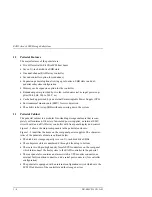
RAID Array 3000 Storage Subsystem
iv
EK–SMCPO–UG. A01
2
RAID Array Controller (continued)
2.6.5
RAID 5............................................................................................ 2–16
2.6.6
JBOD .............................................................................................. 2–18
2.7
System Parameters.............................................................................. 2–18
2.8
Redundant Operation .......................................................................... 2–20
2.8.1
Initialization .................................................................................... 2–20
2.8.2
Message Passing.............................................................................. 2–20
2.8.3
Failover ........................................................................................... 2–20
2.9 Environmental .................................................................................... 2–21
2.9.1
Backup Power Management ............................................................ 2–21
2.9.2
Voltage Monitoring ......................................................................... 2–22
2.9.3
Temperature Monitoring.................................................................. 2–24
3
Maintenance
3.1
Introduction .......................................................................................... 3–1
3.2
Pedestal Status and Power LEDs........................................................... 3–2
3.3
SBB Status LEDs.................................................................................. 3–2
3.4
Controller LEDs ................................................................................... 3–3
3.5
EMU Error Reporting ........................................................................... 3–4
3.6
EMU Error Conditions.......................................................................... 3–4
3.6.1
Replacing Components (FRU’s) ........................................................ 3–5
3.6.2
Removing the Pedestal Door ............................................................. 3–5
3.6.3
Replacing an SBB ............................................................................. 3–6
3.6.4
Replacing a Power Supply................................................................. 3–7
3.6.5
Replacing the RAID Array Controller ............................................... 3–8
3.6.6
Replacing the EMU Board................................................................. 3–9
3.6.7
Replacing the UPS .......................................................................... 3–11
3.7
Differential/Wide UltraSCSI Bus ........................................................ 3–11
3.7.1
Reconfiguring the SCSI Bus ............................................................ 3–12
3.8
Replacing the Controller Memory Cache Modules.............................. 3–16
Summary of Contents for DS-HSZ22-AA
Page 8: ......
Page 10: ......
Page 28: ......
Page 40: ...RAID Array 3000 Pedestal Enclosure 2 12 EK SMCPO UG A01 Figure 2 4 RAID 0 Write ...
Page 60: ...RAID Array 3000 Pedestal Enclosure 3 8 EK SMCPO UG A01 Figure 3 5 Replacing a Power Supply ...
Page 92: ......
Page 94: ......





































